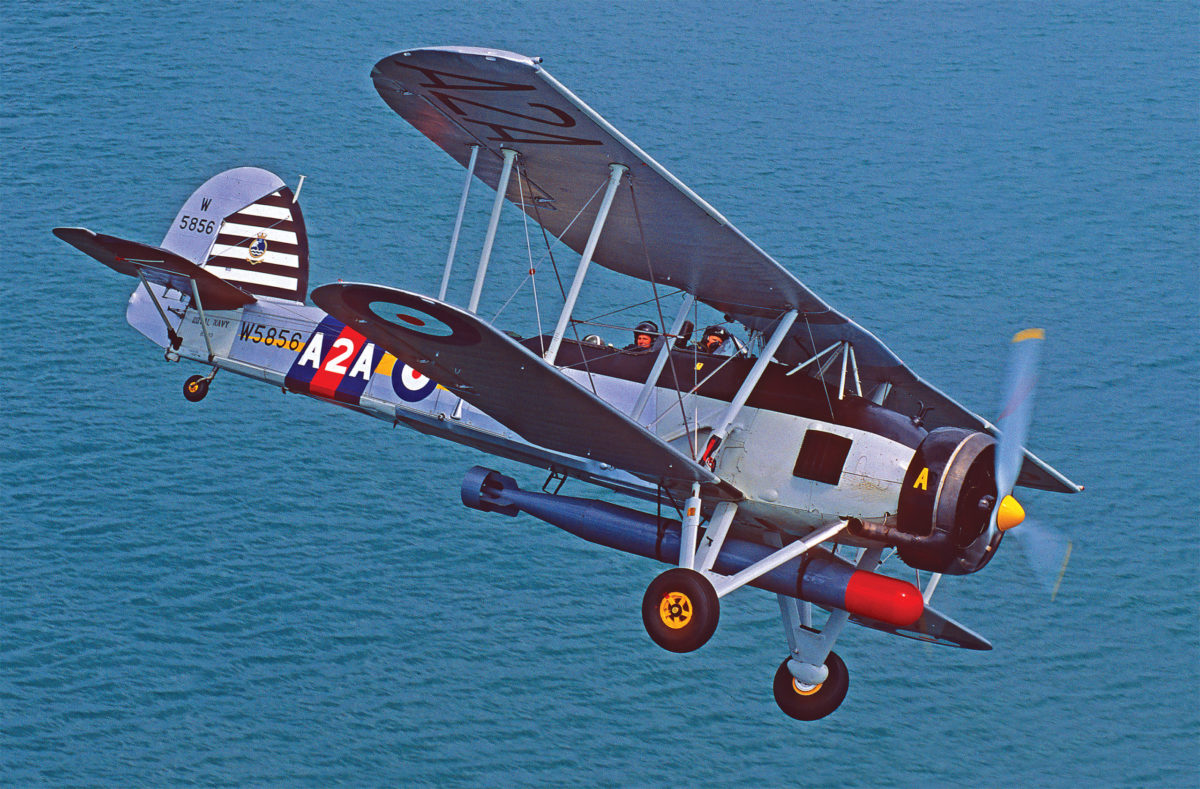The crew of the battleship Bismarck could be proud of themselves and their great ship. Two days earlier, on May 24, 1941, they had sent the pride of the Royal Navy, the battlecruiser HMS Hood, and all but three of its 1,419-man crew to the bottom of the Atlantic. Hit by three shells in return, Bismarck had set course for the port of Brest, in occupied France, to undergo repairs. The only warships that could pose a threat were hundreds of miles away.
Then, at dusk, out of a rainsquall, skimming just above the waves at a leisurely pace, appeared what must have seemed phantoms from the previous war: nine Fairey Swordfish biplanes from the aircraft carrier Victorious, their crews’ heads leaning out of open cockpits. Bismarck’s Captain Ernst Lindemann ordered the helm put hard over. He knew that while the biplanes might be obsolete, the torpedoes they carried were not. The battleship’s anti-aircraft guns unleashed an intense barrage. No planes were shot down, but only one torpedo scored a hit, amidships on the main armor belt, with negligible effect. Bismarck’s crew probably wondered why, in the third year of the war, the Royal Navy had only sent a handful of antique aircraft against them. Tomorrow, they would be close to France, protected by the Luftwaffe and a line of U-boats.
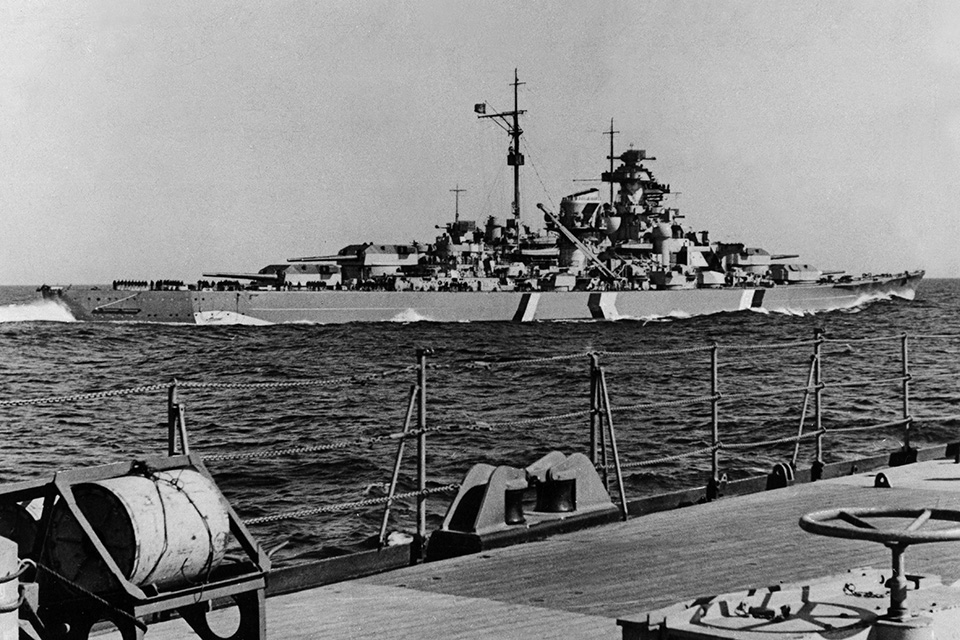
For the British there remained one last, desperate chance to attack. With darkness falling, another flight of 15 Swordfish managed to take off from the wildly pitching deck of the carrier Ark Royal into 70 mph winds. One of their torpedoes again fruitlessly hit the armor belt, but, as Bismarck turned hard to port, a second struck its vulnerable stern. With its rudder jammed, the great ship could only steam in circles. The next day, May 27, the battleships King George V and Rodney, together with several cruisers, appeared on the horizon. Bismarck put up a brave fight, but eventually joined Hood on the ocean floor.
Britain pioneered naval aviation. The Royal Naval Air Service (RNAS) used seaplanes and land-based aircraft during World War I with some notable successes, including bombing the Zeppelin hangars at Cuxhaven, Wilhelmshaven and Tondern. A Short 184 seaplane made history when it sank a Turkish ship by torpedo during the 1915 Gallipoli operation. In 1918 Britain launched Argus, the first aircraft carrier with a full-length flight deck, allowing planes to both take off and land. The British were the first to begin construction of a purpose-designed carrier, Hermes, commissioned in 1924. It set the pattern for future aircraft carriers: a flush flight deck with command superstructure “island” to starboard.
The RNAS and Royal Flying Corps were combined to form the Royal Air Force on April 1, 1918—April Fool’s Day, as some disgruntled RNAS personnel observed. The bizarre result was the Royal Navy operating aircraft carriers with planes and pilots commanded by the RAF.
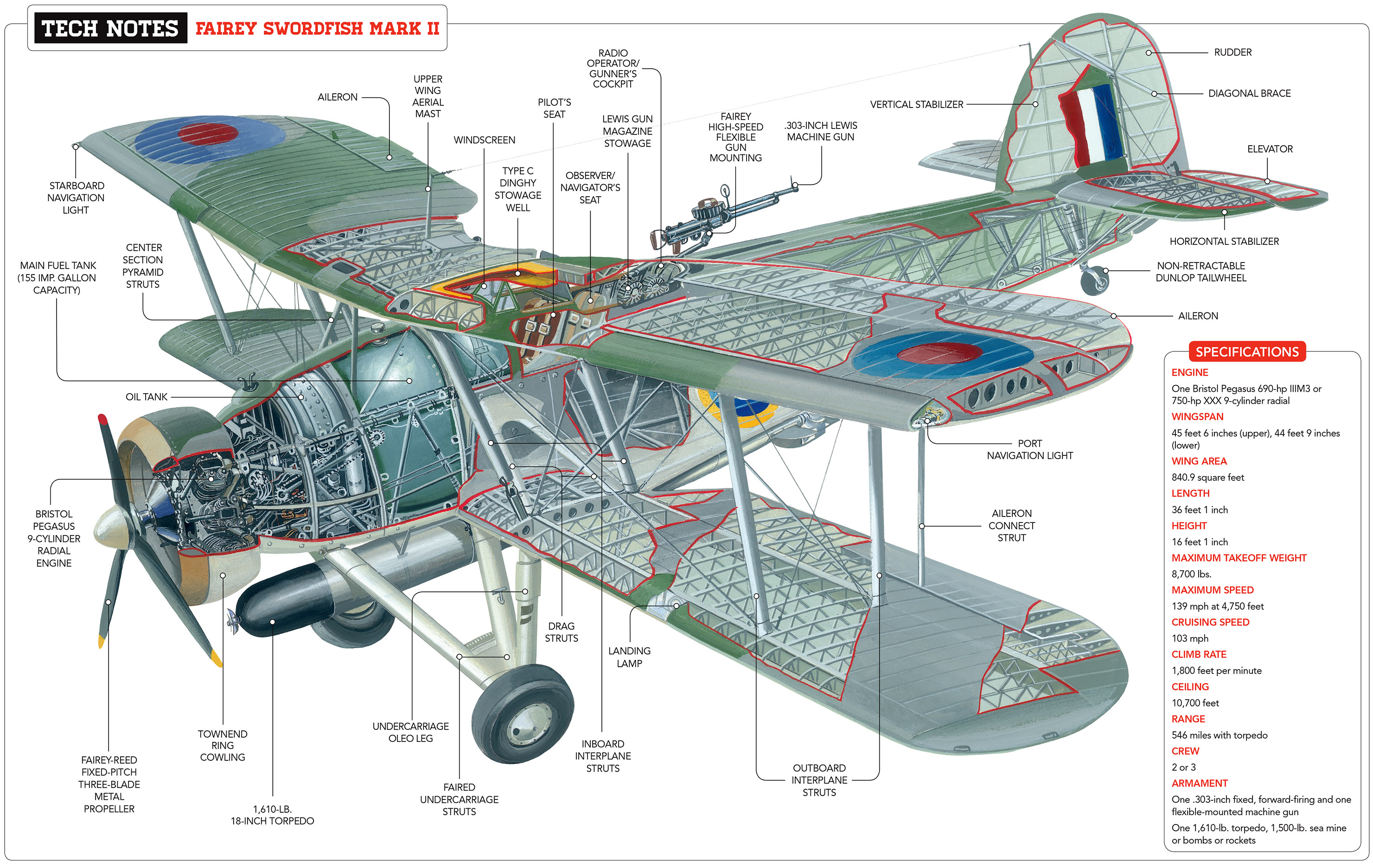
In common with every other naval power, a battleship mentality ruled at the Admiralty during the interwar years. The prevailing view was that future battles would still be fought by ships lining up to slug it out, like at Jutland in 1916. The notion that flimsy flying machines could sink great warships was considered absurd. Vast sums were spent on new battleships, but only a trifle for a few hybrid carriers based on the hulls of merchant ships or of battleships whose construction had been halted by the 1922 Washington Naval Treaty. And nothing for developing carrier aircraft.
Admiral Lord Chatfield, head of the Royal Navy, called this “insanity” for an island nation whose very existence depended on its sea power. He threatened to resign unless naval aviation reverted to the Royal Navy, which it finally did in 1939. At the beginning of World War II, Britain had seven aircraft carriers, more than any other nation (reduced to six when Courageous was torpedoed with the war just 14 days old), but two were 15 years old and four had been launched in the previous war. Only Ark Royal, commissioned in 1938, was reasonably up to date. The government, now with a more visionary Admiralty, canceled battleship building and ordered the construction of modern carriers, 17 of which would enter service beginning in 1940. But the opportunity to develop advanced carrier-borne fighters and bombers had been irretrievably lost.
The Air Ministry had issued a specification for a carrier aircraft in 1930: a biplane with an open cockpit like its RAF contemporaries, such as the Bristol Bulldog. The Fairey Aviation Company responded with the prototype T.S.R. II (for Torpedo-Spotter-Reconnaissance), progenitor of the Swordfish, for which it received a contract a few months later. Significantly, the Swordfish entered service in 1936, the year the first Spitfire flew. Long after other countries had introduced modern all-metal monoplane carrier aircraft with enclosed cockpits, powerful engines and retractable landing gear, for most of the war the “Stringbag,” as it was affectionately known by its crews, was the only effective torpedo, bombing and anti-submarine aircraft available to the Fleet Air Arm. What it achieved in those six years defied all expectations.
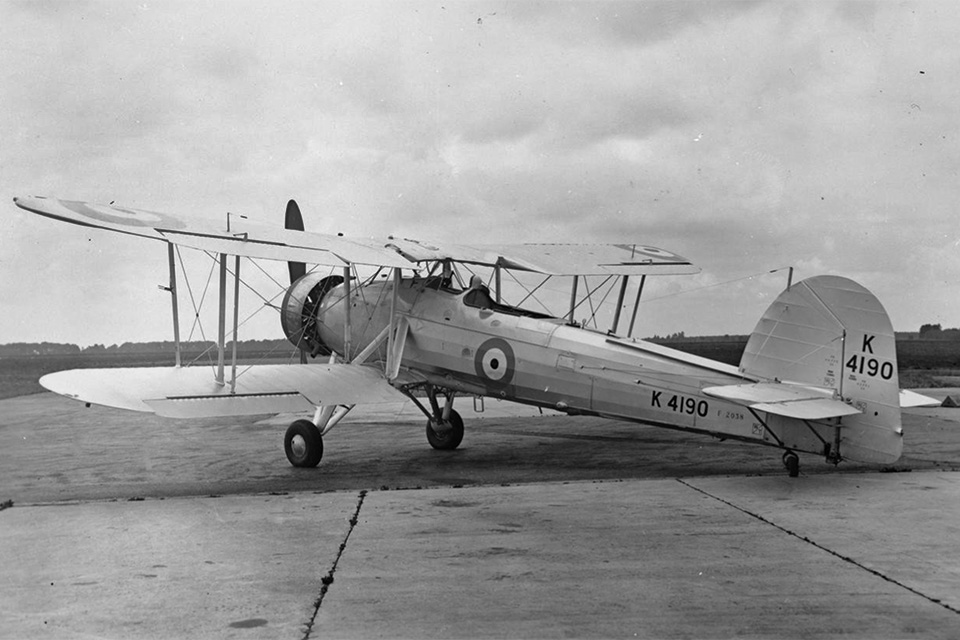
Captain Lindemann and his officers had good reason to respect this apparent relic of a bygone era. In the April 1940 Battle of Narvik, off Norway, a Swordfish catapulted from the battleship Warspite, piloted by Petty Officer Frederick Rice, spotted 10 destroyers supporting the invading German army’s landing. Rice’s radio transmissions corrected the fall of shot from Warspite’s 15-inch guns and allowed British destroyers to ambush their German counterparts, seven of which were destroyed, along with three supply ships. He then dived on the 1,050-ton U-64, and although hit in the tailplane and floats by the submarine’s gunfire, released two bombs. U-64 sank in half a minute, the first sub to be destroyed by an unaided aircraft. Stringbags would go on to sink 15 more, and share in another nine.
The Swordfish’s greatest single achievement came seven months later. The Italian navy’s fleet of fast, modern warships—six battleships, nine heavy cruisers and multiple destroyers—was twice the size of the British Mediterranean fleet. From its main base in Taranto it could threaten key British bases such as Malta, Gibraltar and Alexandria; cut off vital oil from the Middle East; and jeopardize supplies for the British fighting the Italian army in North Africa. Taranto boasted one of the world’s most heavily defended harbors, with hundreds of anti-aircraft guns in shore batteries and on the warships themselves. Barrage balloon cables encircled the anchorage to snare low-flying aircraft, and tests had indicated the harbor waters were too shallow for aerial torpedoes, which simply plunged into the mud.
On the night of November 11, 1940, against this seemingly impregnable fortress, Illustrious launched 20 Swordfish, armed either with torpedoes (modified for shallow water), bombs or flares to illuminate the targets. Pilot Lt. Cmdr. John Godley wrote: “It’s hard to understand how such a decision was ever made. The Charge of the Light Brigade…can it really not have been foreseen that the entire mad venture would end in disaster?”
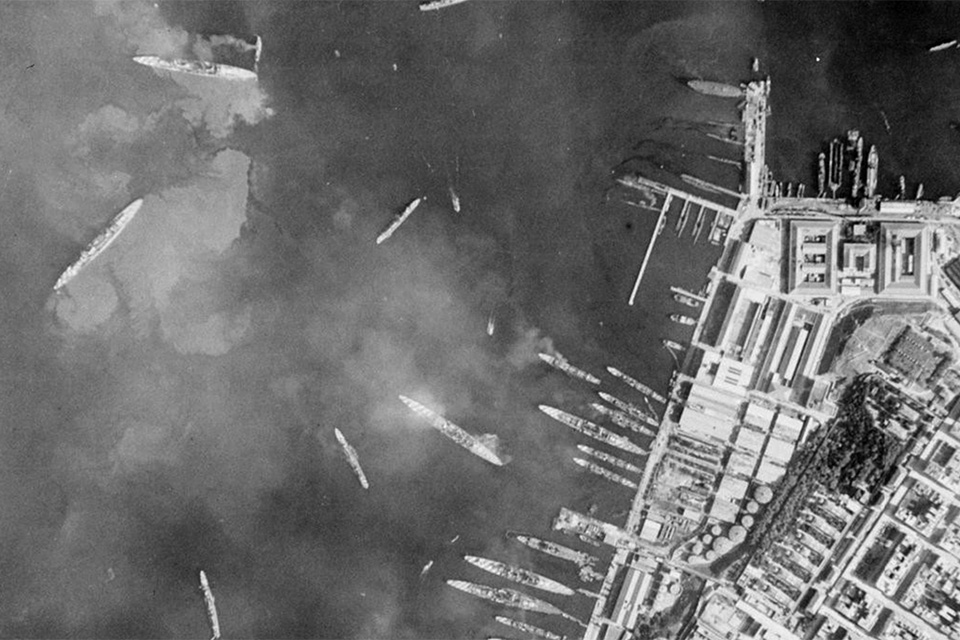
The element of surprise was lost when one plane arrived early, alerting gun and searchlight crews. In the face of intense anti-aircraft fire, the Swordfish torpedoed the battleships Littorio—putting it out of action for the rest of the war—Conte di Cavour and Caio Duilio, plus a cruiser and several destroyers. Conte di Cavour exploded. Caio Duilio took three torpedoes and sank. Despite 14,000 anti-aircraft shells being fired, only two planes were lost, with one crew surviving.
In March 1941, the Italian navy sought revenge against the British in the Mediterranean, leading to the Battle of Cape Matapan. The battleship Vittorio Veneto, eight cruisers and 14 destroyers set out to intercept Admiral Andrew Cunningham’s fleet. British cryptographers, having just broken the Italian naval code, alerted Cunningham. The heavy cruiser Pola was brought to a stop by torpedoes from Formidable’s Swordfish. Vittorio Veneto, hit in the stern and with one propeller smashed, almost suffered Bismarck’s fate, but limped back to its harbor, leaving orders for the cruisers Zara and Fiume and two destroyers to stand by the stricken Pola. That night Cunningham’s ships sank all five. The Italian fleet never again posed a threat to the Royal Navy.
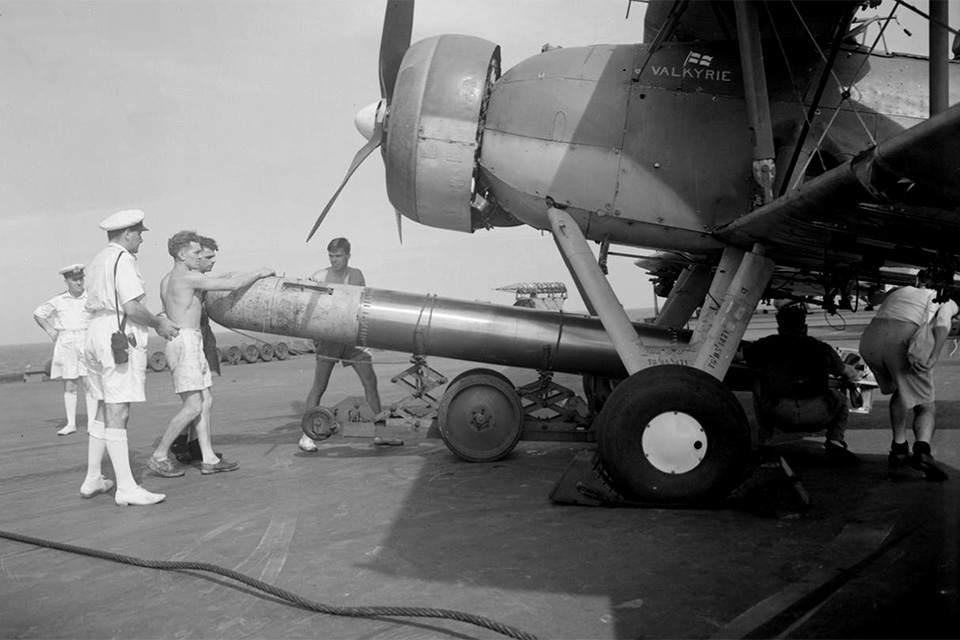
Taranto was momentous in its implications. A handful of carrier aircraft had reversed the naval balance in the Mediterranean, literally overnight. Together with Cape Matapan, it signaled that the days of the battleship as supreme warship were over, that aircraft carriers would play the decisive role in future naval battles and that a powerful fleet in a heavily defended harbor could be devastated by aircraft. Taranto’s significance was recognized in Japan, but apparently not in the United States. A year later, the aerial attack was repeated on a grand scale at Pearl Harbor.
In all, 2,391 Swordfish were manufactured, with production simplified by their uncomplicated structure—wings of steel spars and duralumin ribs, steel-tube fuselage and fabric covering. The original 690-hp Bristol Pegasus engine, which Royal Navy test pilot Captain Eric Brown wrote “from appearances seemed to have been added as an afterthought,” was noted for its reliability, an important consideration to crews flying at night over water. “The Swordfish ambled along lazily at about 85 knots if the wind was favorable,” wrote Brown, but “it was unbelievably easy to fly…no aircraft could have been more tractable or forgiving.”
What the Stringbag lacked in speed it made up for in the multiplicity of armament and equipment it could carry, arguably more than any other aircraft: torpedoes, bombs, mines, flares, Air-to-Surface Vessel (ASV) radar, Leigh Lights (20-million-candlepower spotlights powered by a 300-pound battery), rocket-assisted-takeoff units (RATO) and rocket projectiles (on a fabric-covered plane!). Brown described taking off loaded with a Leigh Light, torpedo and eight anti-submarine bombs: “There was really no logical reason why it should ever have flown with this mass of stores, but fly it did.”
The elongated cockpit, holding pilot, navigator and gunner, tended to act as an air scoop. One test pilot, losing control of the prototype, bailed out, only to be blown back into the rear cockpit, from which he finally exited, becoming the only man in history to have bailed out of the same aircraft twice. The gunner was originally equipped with a WWI-vintage Lewis machine gun, but since its utility against modern fighters was limited, the ex-gunner became the radio operator. All were exposed to the elements, particularly the bitter cold of North Atlantic winters and subzero temperatures on the convoys to Murmansk, Russia. That they could still conduct patrols against U-boats under such conditions, constantly aware that ditching likely meant death, was remarkable. Pilot Lt. Cmdr. Terence Horsley wrote of the Swordfish: “[Y]ou know that you’ve got a friend. And a friend, when you are fighting your way through the darkness towards a lurching flight deck, or are 100 miles out over an empty waste, is something worth having.” Stringbags sank six U-boats on the Murmansk convoys—three on one alone—and shared in the sinking of five more.
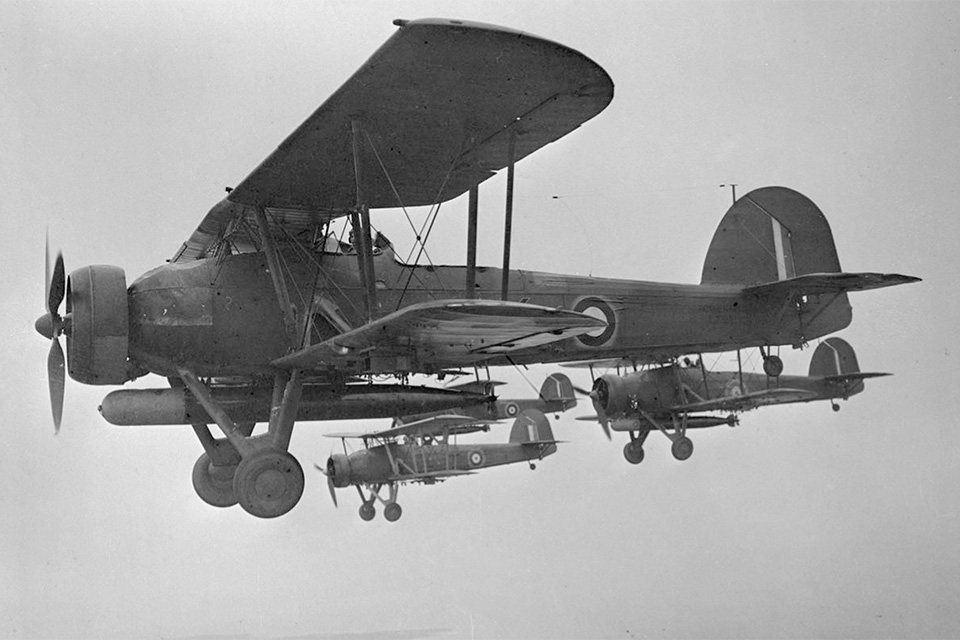
Intended to operate at night, or if by day hopefully beyond the range of land-based enemy fighters, the Swordfish relied on its exceptional maneuverability as its main defense when intercepted. In a vertical bank it could turn around almost in its own length. This or a sudden climb—essentially standing the plane on its tail—presented the attacking fighter pilot with an apparently stationary target disappearing behind him at 300 mph. Attempting to slow and follow these aerobatics would cause a stall. “It will maneuver in a vertical plane easily as straight and level,” Horsley wrote. “It is possible to hold the dive to within 200 feet of the water; a gentle pressure on the stick pulls it out quickly and safely.” Several enemy pilots who tried to follow Swordfish ended up in the sea. But a torpedo attack required flying straight and level, leading to a most tragic, gallant and unnecessary episode.
As a result of continual RAF bombing at the French port of Brest, Adolf Hitler ordered the battlecruisers Scharnhorst and Gneisenau and heavy cruiser Prinz Eugen to safer berths in Wilhelmshaven on the North Sea. On February 11, 1942, together with 25 destroyers, and with aerial cover from several hundred fighters, they steamed up the English Channel in daylight. Hitler believed the British would be slow to react to such an audacious gamble. Due to ill luck, foul weather, radar failure at critical moments and poor communications, the fleet was only spotted when halfway through the Channel. RAF bombers failed to locate it in the poor visibility, bombed ineffectually or were shot down by anti-aircraft fire or fighters. RAF losses totaled 35 aircraft. As the ships passed the Straits of Dover, in an act of desperation Lt. Cmdr. Eugene Esmonde was ordered to attack with just six Swordfish. “He knew what he was going into, but it was his duty,” wrote Wing Cmdr. Tom Gleave. “His face was tense and white, that of a man already dead.” Escorting Spitfires, battling swarms of German fighters, were unable to protect them. Although several launched their torpedoes, all were shot down before coming close enough to achieve a hit. Esmonde was awarded a posthumous Victoria Cross.
Swordfish pioneered the use of ASV radar to attack ships and surfaced U-boats in 1940. It could detect a submarine up to five miles away and larger vessels up to 25. Operating from Malta, the RAF and Fleet Air Arm created havoc among convoys supplying the Italian and German armies in North Africa. A couple dozen Swordfish alone sank an average of 50,000 tons of shipping per month, with a record 98,000 in August 1941.
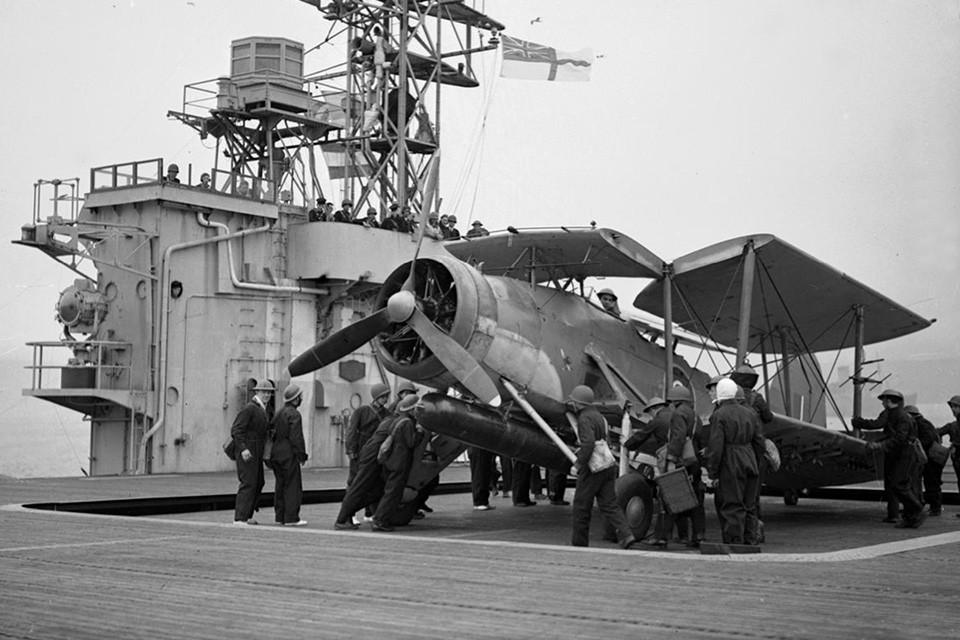
In August 1940 at the Gulf of Bomba, Libya, three Stringbags of No. 813 Squadron had the distinction of sinking four Axis vessels with just three torpedoes. One submarine underway was quickly sunk. The aircrews then spotted a destroyer, with another sub and a depot ship moored on each side. After the Swordfish torpedoed the outer vessels, the depot ship’s munitions exploded, sinking all three vessels.
Britain’s most crucial conflict, however, was in the Atlantic. The majority of the island nation’s food and raw materials, and all of its fuel oil and gasoline, came by sea. By 1942, U-boats were sinking half a million tons a month, rising to 700,000 tons in November. Britain faced a real risk of being starved into surrender. “The only thing that really frightened me during the war was the U-boat peril,” Winston Churchill later wrote. A 500-mile gap in the mid-Atlantic, beyond the range of land-based aircraft, allowed the subs to operate largely unmolested. From May 1943, operating from small escort carriers or merchant aircraft carriers (MACs—merchant ships with short decks built above their holds), Swordfish launched by catapult or RATO helped to close this gap. At night their ASV radar detected surfaced U-boats shadowing a convoy or recharging their batteries. Suddenly illuminated by the Leigh Light, they would be attacked with bombs or depth charges. As a result, the U-boats were forced to surface for battery recharging during the day, when they could at least see the attacking aircraft coming. But now they were prey to the Swordfish’s 30-pound armor-piercing rockets. Fired in pairs or a salvo of all eight, one or two hits usually sufficed.
From May 1943 until V-E Day, only one of the 217 convoys escorted by MACs was successfully attacked. Swordfish would fly 4,177 patrols, sink 10 U-boats and share in the destruction of five more. Already obsolescent when the first one landed on an aircraft carrier, this ugly duckling, outliving several designs meant to replace it, was the only naval aircraft in frontline service from the first day of the European war to the last. Amazingly, the glorious Stringbag was responsible for the destruction of a greater tonnage of Axis shipping in WWII than any other Allied aircraft.
Nicholas O’Dell served in RAF Bomber Command from 1958 to 1962. For additional reading, he suggests: Bring Back My Stringbag: A Swordfish Pilot at War 1940–1945, by Lord Kilbracken; and To War in a Stringbag, by Charles Lamb.
This feature appeared in the March 2019 issue of Aviation History. Subscribe here!

